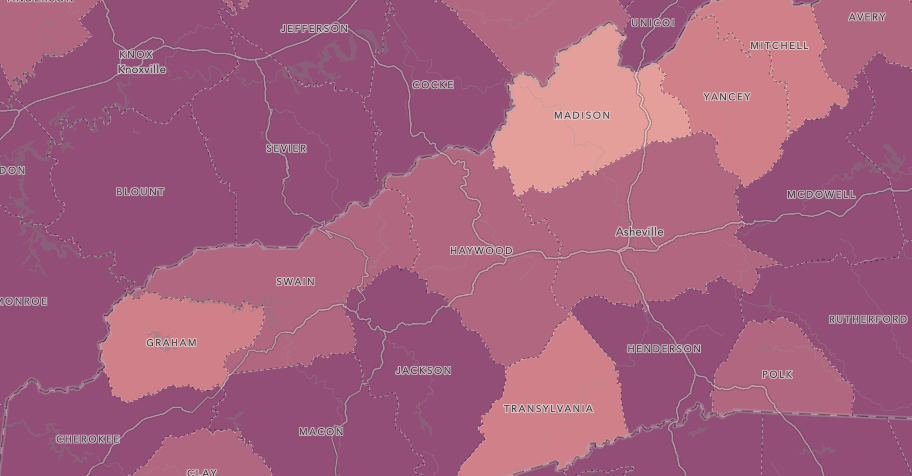North Carolina reported 564 new cases of COVID-19 on Aug. 17, the state’s lowest single-day increase since May 27, according to the N.C. Department of Health and Human Services. The seven-day rolling average of new cases, one of the state’s key trends for assessing the progress of the pandemic, has also been steadily decreasing since mid-July.
On paper, those results look promising. But what do they actually mean for Western North Carolina? How likely are local residents to come in contact with the coronavirus?
As of Aug. 17, 145,516 North Carolina residents had tested positive for COVID-19. According to 2019 U.S. Census information, North Carolina has approximately 10.49 million residents; based on these figures, roughly 1.39% of the state’s population has been infected with the coronavirus.
By raw numbers, Buncombe County has more COVID-19 cases than any other WNC county at 2,092. But it’s also the most populous county in the region: Per capita, Buncombe has registered 81 cases per 10,000 residents.
Of the state’s westernmost counties, four have higher per capita rates than Buncombe. McDowell County has the highest rate at 157 COVID-19 cases per 10,000 residents, followed by Henderson at 134, Rutherford at 125 and Jackson at 106. Three adjacent counties fall below Buncombe’s mark: Haywood reports 75 cases per 10,000 residents, Yancey 45, and Madison 23.
The percentage of positive COVID-19 tests can also be used as a measure of the disease’s prevalence in a community. Of the eight aforementioned counties, only Rutherford, McDowell, Henderson, Haywood and Buncombe counties had positivity data available through NCDHHS, reporting rates of 11%, 7%, 7%, 6% and 5%, respectively.
Haywood nursing home outbreak largest in the state
A COVID-19 outbreak at Silver Bluff Village in Haywood County has become the largest congregate living outbreak in North Carolina, with 51 reported cases among staff, 88 cases among residents and 14 resident deaths, according to data released Aug. 14 by NCDHHS.
“We extend our deepest sympathy to the families and loved ones,” said Patrick Johnson, Haywood County health director, in an Aug. 14 press release. “This is a sad reminder that COVID-19 is a serious and sometimes deadly illness. We urge all citizens to do their part by observing social distancing, wear masks, and practicing good hygiene.”
Statewide, 288 skilled nursing homes and residential care facilities are currently experiencing COVID-19 outbreaks, defined by NCDHHS as two or more cases within a facility. These outbreaks have resulted in 10,315 cases and 1,172 deaths among residents and staff.
Buncombe County is currently experiencing COVID-19 outbreaks at eight facilities: Black Mountain Neuro-Medical Treatment Center, Brian Center Health and Rehabilitation/Weaverville, the Brooks-Howell Home, Deerfield Episcopal Retirement Community’s Simonds Health Care Center, Givens Health Center, Laurels of Summit Ridge, Harmony at Reynolds Mountain and Next Step Recovery.
In other news
- N.C. Chief Justice Cheri Beasley has extended emergency directives to postpone jury trials through the end of September, mandate face coverings and social distancing in court facilities and require an affidavit to be filed with all residential evictions to confirm compliance with the federal CARES Act. The full list of directives can be found here.
- Sen. Chuck Edwards, R-Henderson, has been appointed co-chair of the state’s joint legislative oversight committee on unemployment insurance. The committee is responsible for monitoring the state’s Division of Employment Security, which has paid nearly $7 billion in claims since March 15.
- NCDHHS encourages anyone enrolled in the federal special supplemental nutrition program for women, children and infants to use their monthly food balances. Because of the COVID-19 pandemic, benefits are automatically added to recipients’ eWIC accounts and do not roll over from month to month.




Headline mentions McDowell County, but there is no real discussion about that in article?